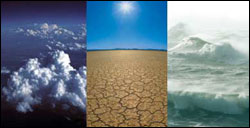Scripps Researchers Find Clear Evidence of Human-Produced Warming in World’s Oceans

Climate warming likely to impact water resources in regions around the globe
Scientists at Scripps Institution of Oceanography at the University of California, San Diego, and their colleagues have produced the first clear evidence of human-produced warming in the world’s oceans, a finding they say removes much of the uncertainty associated with debates about global warming. In a new study conducted with colleagues at Lawrence Livermore National Laboratory’s Program for Climate Model Diagnosis and Intercomparison (PCMDI),
Tim Barnett and David Pierce of Scripps Institution used a combination of computer models and real-world “observed” data to capture signals of the penetration of greenhouse gas-influenced warming in the oceans. The authors make the case that their results clearly indicate that the warming is produced anthropogenically, or by human activities. “This is perhaps the most compelling evidence yet that global warming is happening right now and it shows that we can successfully simulate its past and likely future evolution,” said Tim Barnett, a research marine physicist in the Climate Research Division at Scripps. Barnett says he was “stunned” by the results because the computer models reproduced the penetration of the warming signal in all the oceans. “The statistical significance of these results is far too strong to be merely dismissed and should wipe out much of the uncertainty about the reality of global warming.”
At a news briefing (Feb. 17 at 2 p.m. EST) and symposium presentation (Feb. 18 at 1:45-4:45 p.m. EST) during the 2005 American Association for the Advancement of Science annual meeting in Washington, D.C., Barnett will discuss the details of the study and explain why the results hold implications for millions of people in the near future. According to Barnett, the climate mechanisms behind the ocean study will produce broad-scale changes across the atmosphere and land. In the decades immediately ahead, the changes will be felt in regional water supplies, including areas impacted by accelerated glacier melting in the South American Andes and in western China, putting millions of people at risk without adequate summertime water.
Similarly, recent research by Barnett and his colleagues with the Accelerated Climate Prediction Initiative analyzed climate warming impacts on the western United States using one of the models involved in the new study. The earlier study concluded that climate warming will likely alter western snow pack resources and the region’s hydrological cycle, posing a water crisis in the western U.S. within 20 years. “The new ocean study, taken together with the numerous validations of the same models in the atmosphere, portends far broader changes,” said Barnett. “Other parts of the world will face similar problems to those expected–and being observed now–in the western U.S. The skill demonstrated by the climate models in handling the changing planetary heat budget suggests that these scenarios have a high enough probability of actually happening that they need to be taken seriously by decision makers.”
In the new study, Barnett and his colleagues used computer models of climate to calculate human-produced warming over the last 40 years in the world’s oceans. In all of the ocean basins, the warming signal found in the upper 700 meters predicted by the models corresponded to the measurements obtained at sea with confidence exceeding 95 percent. The correspondence was especially strong in the upper 500 meters of the water column.
It is this high degree of visual agreement and statistical significance that leads Barnett to conclude that the warming is the product of human influence. Efforts to explain the ocean changes through naturally occurring variations in the climate or external forces- such as solar or volcanic factors–did not come close to reproducing the observed warming.
In addition to Barnett and Pierce, coauthors of the study include Krishna Achutarao, Peter Gleckler and Benjamin Santer of Lawrence Livermore National Laboratory.
The global climate models used in the study included the Parallel Climate Model from the National Center for Atmospheric Research and Department of Energy (DOE) and the HadCM3 from the Hadley Centre (United Kingdom). The sharing of these model results made this study possible, says Barnett. The work was a contribution on behalf of the International Detection and Attribution Group (IDAG), which is sponsored by the National Oceanic and Atmospheric Administration’s (NOAA) Climate Change Data Detection Program, a jointly funded NOAA and DOE program. Additional support was provided by DOE through support of PCMDI and Scripps.
Media Contact
More Information:
http://www.ucsd.eduAll latest news from the category: Ecology, The Environment and Conservation
This complex theme deals primarily with interactions between organisms and the environmental factors that impact them, but to a greater extent between individual inanimate environmental factors.
innovations-report offers informative reports and articles on topics such as climate protection, landscape conservation, ecological systems, wildlife and nature parks and ecosystem efficiency and balance.
Newest articles

Silicon Carbide Innovation Alliance to drive industrial-scale semiconductor work
Known for its ability to withstand extreme environments and high voltages, silicon carbide (SiC) is a semiconducting material made up of silicon and carbon atoms arranged into crystals that is…

New SPECT/CT technique shows impressive biomarker identification
…offers increased access for prostate cancer patients. A novel SPECT/CT acquisition method can accurately detect radiopharmaceutical biodistribution in a convenient manner for prostate cancer patients, opening the door for more…

How 3D printers can give robots a soft touch
Soft skin coverings and touch sensors have emerged as a promising feature for robots that are both safer and more intuitive for human interaction, but they are expensive and difficult…





















